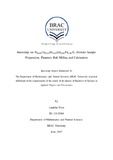| dc.contributor.advisor | Rahman, Muhammad Lutfor | |
| dc.contributor.author | Noor, Lamisha | |
| dc.date.accessioned | 2018-02-06T05:01:11Z | |
| dc.date.available | 2018-02-06T05:01:11Z | |
| dc.date.copyright | 2017 | |
| dc.date.issued | 2017-06 | |
| dc.identifier.other | ID 13115004 | |
| dc.identifier.uri | http://hdl.handle.net/10361/9393 | |
| dc.description | This internship report is submitted in partial fulfillment of the requirements for the degree of Bachelor of Applied Physics and Electronics, 2017. | en_US |
| dc.description | Cataloged from PDF version of internship report. | |
| dc.description | Includes bibliographical references (page 28). | |
| dc.description.abstract | The purpose of the internship was to provide with a firsthand experience on how to measure and prepare a precise amount of the ferrite composite, Ni0.48Cu0.12Zn0.40Gd0.04Fe1.96O4 which was then further planetary ball milled for fourteen hours to achieve homogeneous distribution at 230 rpm, hand milled for a further four hours in two separate sessions using an agate pestle and mortar and finally calcined at 950℃ afterward using a Nabertherm p330 to drive off water, carbon dioxide, other volatile constituents and to oxidize the whole composite. In order to prepare the sample, first the stoichiometric ratio was found and then the exact amount of each required compound was measured separately using an AX120 electronic balance as it provides a high precision of 10 μg and has a full range TARE to allow unladen weight measurement. Planetary ball mill was used for grinding to ensure quick contamination free grinding down of the prepared sample to nano range. Nabertherm P330 was used for calcination as it can be functioned to allow and ensure easy setting of temperature values, time specifications and gradient specifications. These were crucial as the calcination process required the buildup of temperature over a span of two hours in intervals of 10℃ up to 950℃, held at that for five hours and then cooled back in instalments of 5℃. The final product was again ball milled to get rid of clusters and turned into powder thereby completing the preparation of the ferrite sample. | en_US |
| dc.description.statementofresponsibility | Lamisha Noor | |
| dc.format.extent | 28 pages | |
| dc.language.iso | en | en_US |
| dc.publisher | BRAC University | en_US |
| dc.rights | BRAC University Internship report are protected by copyright. They may be viewed from this source for any purpose, but reproduction or distribution in any format is prohibited without written permission. | |
| dc.subject | Planetary Ball Milling | en_US |
| dc.subject | Calcination | en_US |
| dc.title | Ni0.48Cu0.12Zn0.40Gd0.04Fe1.96O4 (Ferrite) sample preparation, planetary ball milling and calcination | en_US |
| dc.type | Internship report | en_US |
| dc.contributor.department | Department of Mathematics and Natural Sciences, BRAC University | |
| dc.description.degree | B. Applied Physics and Electronics | |

